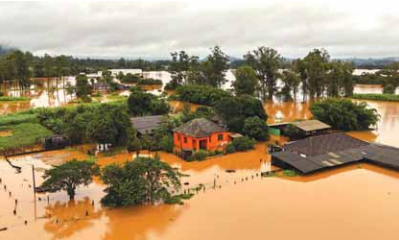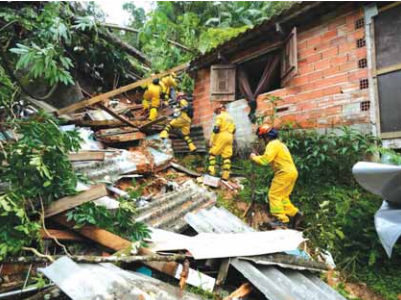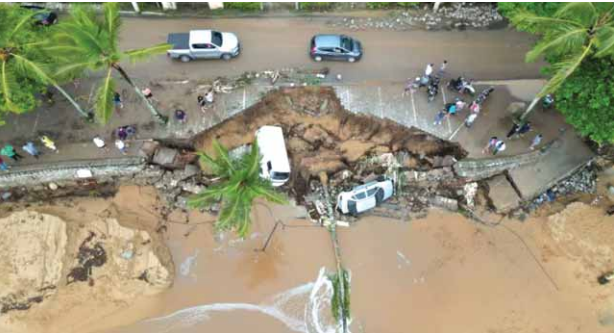January 15, 2025: Heavy rains caused flooding in coastal cities of southern Brazil, including Balneário Camboriú and Itapema. The floods led to the displacement of entire communities and significant damage to infrastructure.
January 2025 – Vale do Aço, Brazil — The metropolitan region of Vale do Aço, located in the interior of Minas Gerais, Brazil, faced a catastrophic natural disaster between January 12 and 13, 2025, as extreme precipitation led to severe floods and landslides. The heavy rains resulted in significant devastation across the four municipalities in the region—Coronel Fabriciano, Ipatinga, Santana do Paraíso, and Timóteo—with Ipatinga experiencing the most substantial impact.
Unprecedented Rainfall and Landslides
The torrential rains, attributed to the South Atlantic Convergence Zone (ZCAS), triggered widespread flooding and landslides across the region. Ipatinga, the hardest-hit city, recorded ten fatalities caused by landslides, including two children. Coronel Fabriciano and Santana do Paraíso each reported one fatality. In total, more than 180 people were left homeless, with thousands affected by the disaster.
Rain gauges installed by the National Center for Monitoring and Early Warning of Natural Disasters (CEMADEN) reported extreme rainfall levels. In Ipatinga’s Betânia neighborhood, over 200 millimeters (7.9 inches) of rain fell within six hours, nearly equaling the city’s monthly average rainfall for January. Similar levels of rainfall were recorded in neighbouring municipalities, exacerbating the crisis.
Widespread Destruction and Infrastructure
Collapse
The floods caused landslides that buried homes, particularly in the neighbourhoods of Betânia, Canaã, and Vila Celeste in Ipatinga. One particularly tragic incident saw five members of a single family killed when a slope collapsed onto their home in Betânia. In Santana do Paraíso, landslides obstructed roads, cutting off access to Mesquita and Bom Jesus do Bagre.
Infrastructure damage was extensive. In Ipatinga, the Unidade de Pronto Atendimento (UPA) in the Canaã neighborhood was inundated, forcing patient evacuations to neighboring healthcare facilities. Commercial districts suffered immense losses, with Avenida José Selim de Sales, a primary business hub, heavily impacted. Even after floodwaters receded, mud and debris coated streets, homes, and businesses, hampering recovery efforts.
Public transportation and major roadways also suffered disruptions. The urban section of BR-381 was completely submerged near Shopping Vale do Aço, halting traffic. Similarly, Avenida Maanaim sustained severe structural damage due to the overflowing Taúbas stream. In Coronel Fabriciano, a slope threatened to collapse, leading to the closure of Avenida Rubem Siqueira Maia, a key roadway.

Emergency Response and Displacement
The Civil Defense issued emergency alerts to residents via mobile notifications and sirens, warning of further landslides and flooding. Despite these measures, the rapid onset of the disaster left many vulnerable. By January 15, the death toll from the broader rainy season across Minas Gerais had climbed to 26, with approximately 130 individuals left homeless in Ipatinga alone and 400 displaced. The floods affected over 85,000 people in the region by January 14.
Timóteo faced its own challenges, as a landslide isolated part of the city and flooded the Fórum Geraldo Perlingeiro de Abreu courthouse. Around 260 families in the municipality were affected, many requiring urgent assistance.
Historical Context and Urban Vulnerability
The Região Metropolitana do Vale do Aço is characterized by rugged terrain and high population density in informal urban settlements. Decades of unplanned urban expansion have forced residents to build homes near watercourses and on unstable slopes, significantly increasing their vulnerability to natural disasters. This lack of adequate land-use planning has made flooding and landslides recurrent threats.
Less than a month before the January 2025 floods, Coronel Fabriciano had already suffered a devastating storm in December 2024, which left more than 1,000 people homeless or displaced. The compounding effects of these extreme weather events underscore the urgent need for improved disaster risk management and infrastructure resilience in the region.

Looking Ahead: Recovery and Mitigation Efforts
As recovery efforts continue, local authorities and humanitarian organizations are working to provide aid to affected residents. The floods have reignited discussions on the necessity of sustainable urban planning and enhanced early-warning systems to mitigate future disasters.
The Vale do Aço floods of January 2025 serve as a stark reminder of the escalating risks posed by extreme weather events in vulnerable urban areas. With climate change expected to increase the frequency and intensity of such phenomena, a concerted effort toward disaster preparedness and resilient urban development is more critical than ever.
Source:
www.relifweb.int






